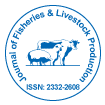Harnessing Next-Gen Analytics to Drive the Future of Fisheries
Received: 01-Apr-2025 / Manuscript No. jflp-25-164708 / Editor assigned: 03-Apr-2025 / PreQC No. jflp-25-164708 / Reviewed: 17-Apr-2025 / QC No. jflp-25-164708 / Revised: 21-Apr-2025 / Manuscript No. jflp-25-164708 / Published Date: 28-Apr-2025
Keywords
Next-generation analytics; Fisheries management; Big data; Sustainability; Decision-making tools
Introduction
The global fisheries sector is undergoing a transformative shift, driven by the integration of next-generation analytics [1]. As marine ecosystems face mounting pressure from overfishing, climate change, and habitat degradation, there is a growing need for innovative approaches to fisheries management [2]. Next-gen analytics which includes big data processing, machine learning, and real-time predictive modeling offers powerful tools to enhance decision-making, optimize resource use, and ensure the long-term sustainability of fish stocks [3]. By unlocking insights from vast datasets, these advanced technologies enable more accurate forecasting, efficient monitoring, and adaptive responses to environmental and economic changes. Embracing next-gen analytics is key to building a smarter, more resilient future for fisheries worldwide [4].
Discussion
The integration of next-generation analytics into fisheries management is revolutionizing how data is utilized to address complex challenges in the aquatic sector [5]. Traditional methods, while valuable, often struggle to keep pace with the dynamic nature of marine ecosystems and the increasing demand for sustainable practices. Next-gen analytics leverages technologies such as big data platforms, machine learning algorithms, satellite monitoring, and predictive modeling to offer deeper, real-time insights into fish population dynamics, fishing efforts, market trends, and environmental variables [6]. These tools enable decision-makers to move from reactive to proactive strategies, forecasting fish stock fluctuations, detecting illegal fishing activities, and optimizing harvest timing and locations. Moreover, these analytics enhance traceability and transparency across the supply chain, fostering consumer confidence and regulatory compliance [7]. For example, integrating data from vessels, ports, and processing centers ensures accurate documentation of fish sources and catches. Next-gen analytics also supports ecosystem-based management approaches by evaluating cumulative impacts on biodiversity and habitat health, helping to maintain ecological balance [8]. The scalability and adaptability of these technologies make them suitable for both large industrial fisheries and small-scale operations, contributing to inclusivity in fisheries development [9]. However, challenges such as data standardization, infrastructure gaps, and capacity building must be addressed to fully realize the benefits of these innovations. With continued investment and cross-sector collaboration, next-gen analytics holds the potential to drive smarter, more sustainable fisheries that are resilient in the face of environmental and socio-economic changes [10].
Conclusion
Next-generation analytics is shaping a new era for fisheries by enabling data-driven, forward-looking approaches to management and sustainability. Through advanced tools like machine learning, predictive modeling, and real-time monitoring, stakeholders can make more accurate, timely, and informed decisions. These innovations not only enhance resource efficiency and ecological stewardship but also empower small- and large-scale fisheries alike to adapt to environmental changes and market demands. While challenges remain in terms of infrastructure, training, and data accessibility, the strategic adoption of next-gen analytics promises to transform fisheries into smarter, more resilient systems capable of sustaining both livelihoods and marine biodiversity for generations to come.
References
- Melaku T (2011) Oxidization versus Tractorization: Options and Constraints for Ethiopian Framing System. Int J Sustainable Agric 3: 11-20.
- World Bank (2017) International Development Association: Project Appraisal Document on a Proposed Credit in the Amount of SDR 121.1 Million (US$ 170 Million Equivalent) to the Federal Democratic Republic of Ethiopia for a Livestock and Fisheries Sector Development Project (Project Appraisal Document No. PAD2396). Washington DC.
- FAO (2014) OECD, Food and Agriculture Organization of the United States, Agricultural Outlook 2014, OECD Publishing FAO.
- Belay G, Negesse T (2019) Livestock Feed Dry Matter Availability and Utilization in Burie Zuria District, North Western Ethiopia. Trop Subtrop Agroecosystems 22: 55–70.
- Management Entity (2021) Ethiopia’s Livestock Systems: Overview and Areas of Inquiry. Gainesville, FL, USA: Feed the Future Innovation Lab for Livestock Systems.
- Azage T (2004) Urban livestock production and gender in Addis Ababa. ILRI (International Livestock Research Institute). Addis Ababa, Ethiopia. Urban Agric Mag 12:3.
- Balehey S, Tesfay G, Balehegn M (2018) Traditional gender inequalities limit pastoral women’s opportunities for adaptation to climate change: Evidence from the Afar pastoralists of Ethiopia. Pastoralism 8.
- Emama B, Mohammed H, Mohammed S (2015) A situational analysis of agricultural production and marketing, and natural resource management systems in the Ethiopian highlands. ILRI, Addis Ababa, Ethiopia.
- Environmental Policy Review (EPR) (2011) Livestock Production Systems and their Environmental Implications in Ethiopia.
- Food and Agricultural Organization (FAO) (2019) FAOSTAT database.
Google Scholar, Crossref, Indexed at
Citation: Tinian L (2025) Harnessing Next-Gen Analytics to Drive the Future of Fisheries. J Fisheries Livest Prod 13: 644.
Copyright: © 2025 Tinian L. This is an open-access article distributed under the terms of the Creative Commons Attribution License, which permits unrestricted use, distribution, and reproduction in any medium, provided the original author and source are credited.
Select your language of interest to view the total content in your interested language
Share This Article
Recommended Journals
Open Access Journals
Article Usage
- Total views: 908
- [From(publication date): 0-0 - Dec 10, 2025]
- Breakdown by view type
- HTML page views: 779
- PDF downloads: 129
